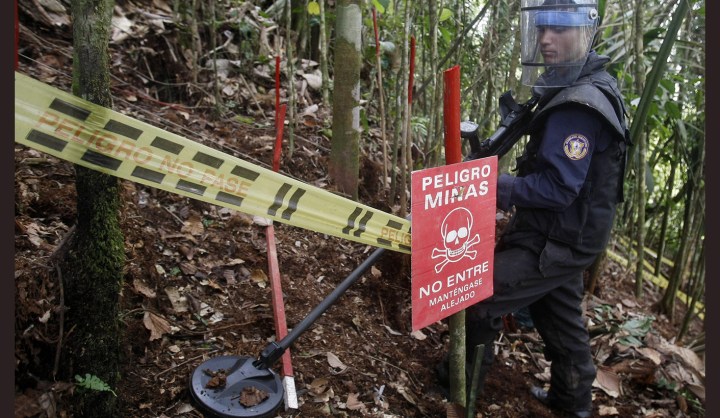World
Analysis: Demining the path to peace in Colombia

On 7 March, negotiators for the Colombian government and the Revolutionary Armed Forces of Colombia (FARC) announced that they would embark on a joint demining effort. After two-and-a-half years of negotiations in the Cuban capital of Havana, and outline agreements on three agenda points, this is the first accord that will have a direct impact on the ground, delivering long overdue humanitarian relief and bringing Colombia a big step closer to ending five decades of bloodshed. By CHRISTIAN VOELKEL for the INTERNATIONAL CRISIS GROUP.
Colombia is one of the most landmine-contaminated countries in the world. Since guerrillas began systematically using them in the early 1990s, the devices have killed or injured over 11,000 persons, mostly members of the security forces. Landmines are now a threat in about 700 of Colombia’s 1,100-odd municipalities, and have contributed to displacing over six million Colombians. In the most dangerous regions, such as the southern Lower Putumayo region, landmine contamination blocks communities’ access to schools, health services and local markets.
According to a joint statement, the government and FARC will first select a number of pilot zones with the highest level of threat for anti-personnel mines, improvised explosive devices (IEDs), unexploded ordnance (UXO) or explosive remnants of war (ERW). Norwegian People’s Aid, a humanitarian non-governmental organization (NGO), will then survey where most of the explosive devices are. This is a particular challenge in Colombia, where mines are often widely dispersed, not laid out in regular patterns. Reliable maps are also often absent. Following mine clearance, safe territories will be handed over to communities and local authorities.
If implemented thoroughly, the agreement will not just remove deadly threat for some of Colombia’s most vulnerable communities. It will also help strengthen the Havana talks and the prospects for durable peace in at least six different ways:
- Building trust between the parties. The joint statement notes that demining is a joint commitment. Government officials and FARC members – unarmed and without uniforms – will work together to identify priority zones, verify progress and jointly hand over cleared areas. Such collaboration should chip away at deep distrust between the parties, built up over decades of war and failed peace negotiations. As Crisis Group argued in a recent report, confidence in the process and faith that the other side is doing everything it can to end the conflict are critical for the success of an eventual bilateral ceasefire and for convincing FARC to “leave behind” its weapons (dejar las armas).
- Winning buy-in from local communities. Successful demining will address the deep-seated scepticism of communities in conflict regions. Many do not fully trust either side and fear the peace process will just transform the violence or make it worse. For FARC, acting to remove landmines, instead of calling them a military necessity in an irregular war, can begin to repair the damage it has inflicted. This is not just an ethical imperative, but also a necessity if the guerrillas want to transform themselves into a legitimate political movement. For their part, the government and the military, which will participate through its humanitarian demining battalion, can use landmine removal to prove their commitment not just to eliminating guerrillas, but to tackling the intricate day-to-day problems of communities in conflict zones.
- Stabilising FARC’s ceasefire. Despite ongoing counter-insurgency operations, the guerrillas’ unilateral, indefinite ceasefire has held since last December. But doubts about its sustainability have risen amid allegations of the first violations. The demining agreement sets the parties on a clear path to de-escalate their conflict and reach an eagerly awaited bilateral ceasefire; in practice, demining will already create highly localised informal truces in areas where both FARC and the government have strategic interests and which up to now have been off-limits for humanitarian deminers. This prospect should help avert the twin spectres of an eroding FARC truce and the political backlash this would trigger.
- Buying time for negotiators. With broader support for the peace process largely conditional on demonstrating concrete progress, the demining deal gives delegations in Havana a much needed respite. It also reduces the pressure to reach quick results in tough negotiations on transitional justice. Conversations on this most divisive agenda point have been underway since mid-2014, but little suggests an agreement is coming soon. Advances in demining (and additional conflict de-escalation measures) will help buy the time needed to reach a politically and legally sustainable transitional justice accord.
- Facilitating rural development. Over the longer term, demining is a necessary (although not sufficient) condition for improving life in the countryside. Ending landmine contamination will allow rural development to progress. It will ease the way for government initiatives to hand back land seized by illegal armed actors and for the implementation of agrarian development measures agreed on in Havana.
- Helping make Colombia compliant with its treaty obligations. On paper, tackling landmines has long been a priority. But in reality, progress has been slow. Colombia was granted its request for an extension until 2021 to meet its contractual obligations under the Ottawa Convention, an international treaty which aims to eliminate landmines. And even that goal has started to look ambitious, as demining has fallen behind schedule amid continuing conflict and slow creation of military and civilian capacities. The demining agreement in Havana should be a shot in the arm for these delayed efforts.
The 7 March agreement between the Colombian government and FARC is short on details and none of the benefits listed above are guaranteed. Failure to implement the accord, or security incidents involving FARC representatives, could become new obstacles to peace, distracting the attention of negotiators from the remaining agenda issues and deepening distrust.
Expectations will also need to be managed. Some mines can be quickly removed, but complete demining is a long-term challenge. On the Peru-Ecuador border, fifteen years after hostilities ceased, an estimated 10,000 mines still lurk in the ground. Demining will therefore stretch long into the post-conflict period and require significant additional capacities. Sensibly, the agreement is open to other organisations to help, such as Halo Trust, currently the sole NGO accredited to carry out humanitarian demining in Colombia. With total costs estimated at around $100 million, long-term support from the international community will be vital for a sustainable demining effort.
But the importance of last week’s demining agreement should not be underestimated. After FARC’s unilateral ceasefire, it is the first joint step the parties have taken to stop the violence. With it the Havana negotiations have finally arrived in Colombia. DM
Christian Voelkel is Crisis Group’s Senior Colombia/Andes Analyst.
Read more:
- Colombia: From a political economy of war to an inclusive peace in Daily Maverick.
Photo: Members of the Colombian Army work to clear a zone of mines during a demining operation in the municipality of Cocorna, Antioquia, Colombia, 03 March 2015. EPA/LUIS EDUARDO NORIEGA



















 Become an Insider
Become an Insider